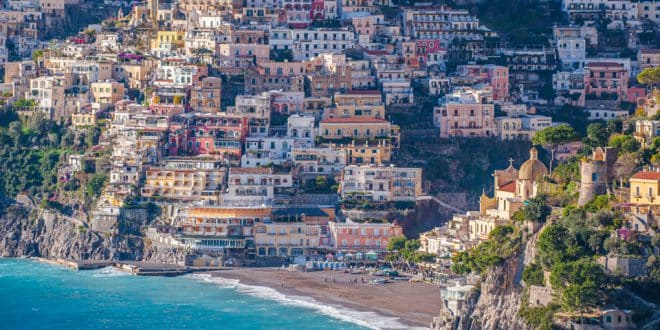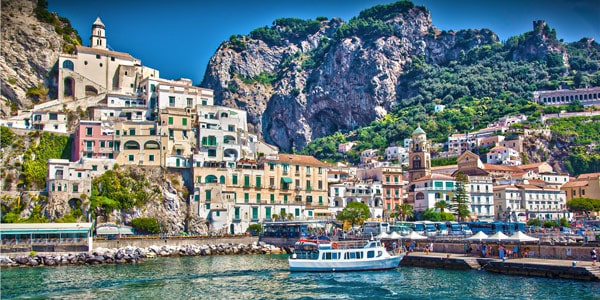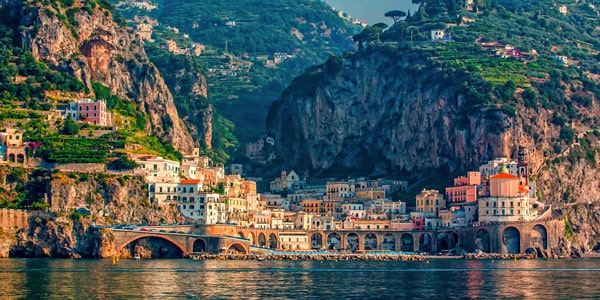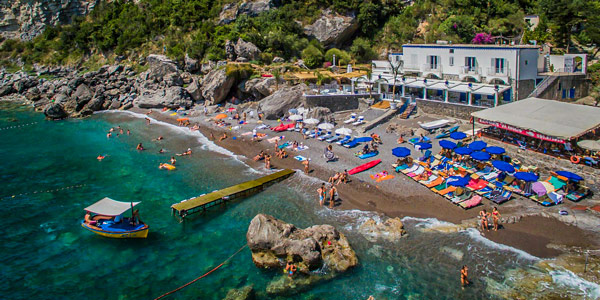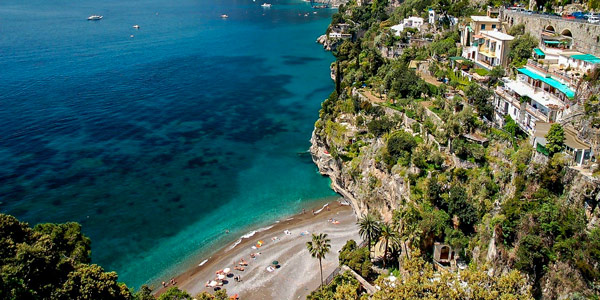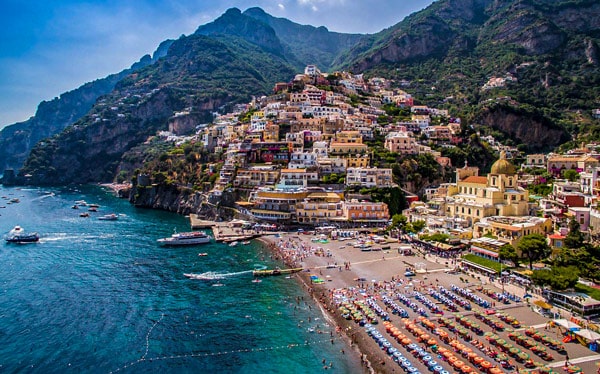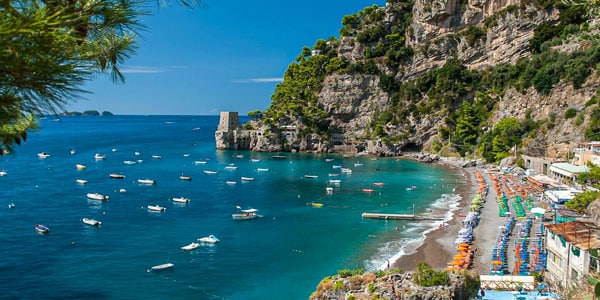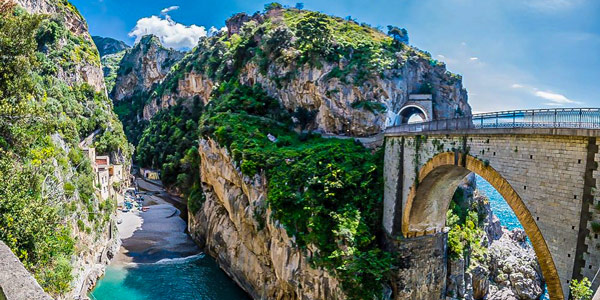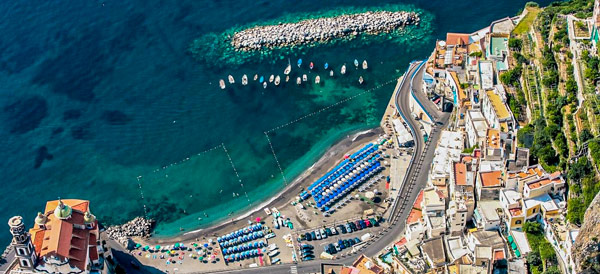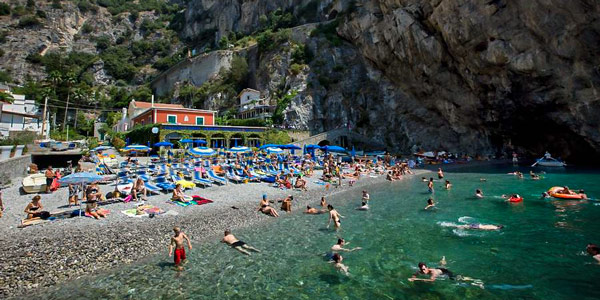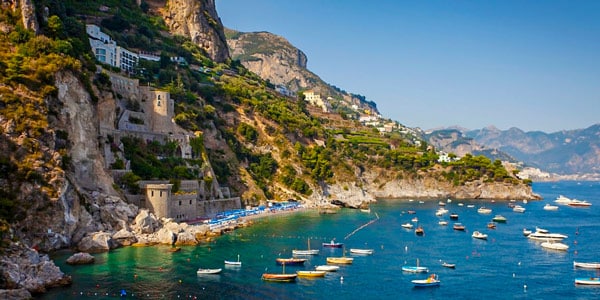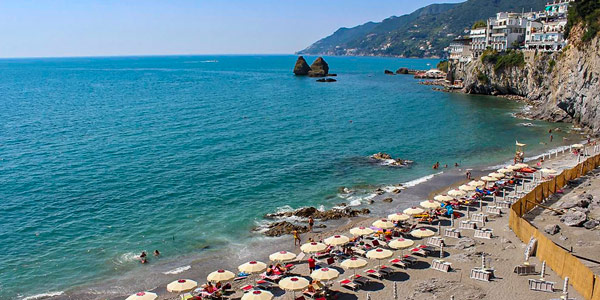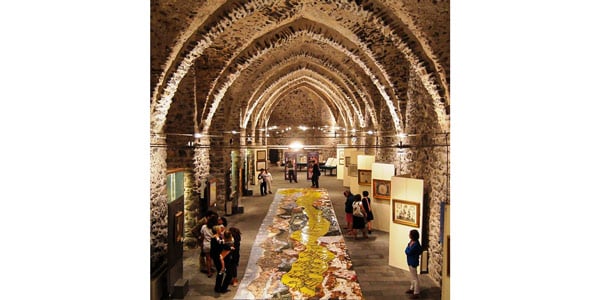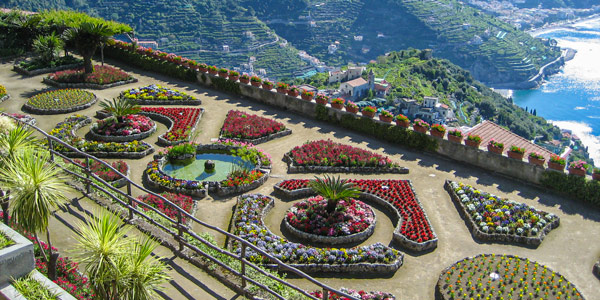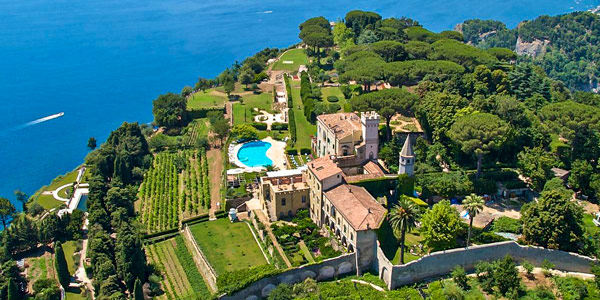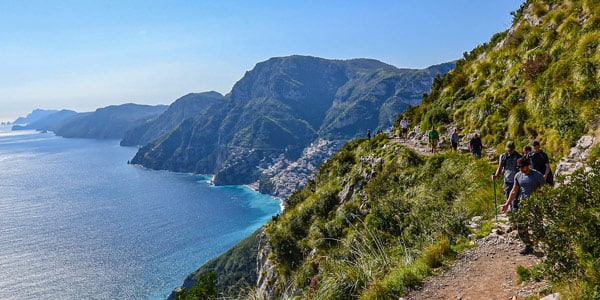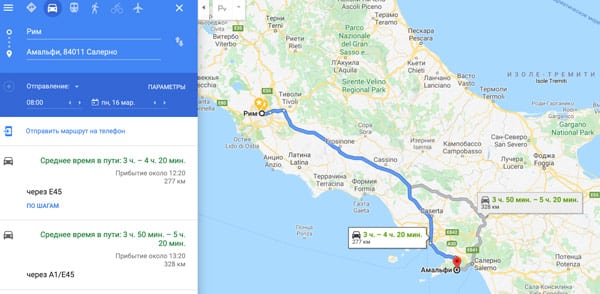In southern Italy, in the Campania region, there is a fabulous Amalfi Coast (Costiera Amalfitana), washed by the warm waters of the Tyrrhenian Sea (mar Tirreno) in the Gulf of Salerno (Golfo di Salerno).
The small cozy towns of this charming place are scattered along the entire coast on the slopes and rocky cliffs of the majestic mountains of Lattari (Monti Lattari), creating a complex openwork pattern of the coastline.
Multi-colored houses perched on stone terraces and immersed in the greenery of citrus groves and vineyards create a unique flavor of a magnificent picture painted by nature itself and recognizable worldwide.
Page Contents
Best Towns of the Amalfi Coast
The Amalfi Coast stretches for 50 km from the south side of the Sorrento Peninsula and occupies 11,231 hectares between the Gulf of Naples (Golfo di Napoli) and the Gulf of Salerno (Golfo di Salerno). There are 13 municipalities on this section, they are listed in order if you go from Salerno to Sorrento:
- Positano
- Praiano
- Furore
- Conca dei Marini
- Amalfi
- Atrani
- Scala)
- Ravello
- Minori
- Maiori
- Tramonti
- Cetara
- Vietri Sul Mare
The picturesque Amalfitana road (section Strada Statale 163), built in the first half of the 19th century on the site of an old Roman road, connects all the towns on the coast. Running along a natural curve of coastline between cliffs and sea cliffs, Amalfitana offers unexpected and enchanting views of the Gulf of Salerno with every turn.
The tourist era of the Amalfi Coast began in the 17th-18th centuries during the Grand Tour, when travelers from other countries, carried away by the history and the search for artifacts of Great Greece and Rome, discovered for themselves and the whole world the picturesque landscapes and magnificent beaches of the coast of the Gulf of Salerno.
Towns with their beaches and historical sights are very popular with tourists.
Amalfi
The central city that gave its name to the coast is Amalfi, which in the 11th-12th centuries was the capital of the Maritime Republic of Amalfi, an essential trading power in the Mediterranean.
The city is located at the mouth of a deep ravine, at the foot of Monte Cerreto, 1315 meters high, surrounded by cliffs and coastal landscapes. The commune has a little over 5,000 inhabitants living in a small area of 5.7 sqm.
Amalfi is located in the center of the Amalfi Coast and is the heart of a protected corner of nature. This is one of the most popular resorts visited by tourists, as many historical values are concentrated here, beautiful beaches and, of course, the main attraction is fantastic views.
Among believers, the town is known as a place of pilgrimage to the relics of St. Andrew the First-Called, which are kept in the Cathedral (Cattedrale di Sant’Andrea).
Amalfi has preserved the structure and atmosphere of a medieval city with amazing tunnels of narrow streets, centuries-old steps carved into the rocks, ancient churches, and small squares.
Read also about the best beaches in Italy
Atrani
Small and delightful Atrani literally adjoins Amalfi; You can get from one town to another by steps carved into the rock separating them.
Founded simultaneously with Amalfi, the small port city is unique today in that it has fully preserved the features of the ancient settlement. Its inhabitants never called themselves Amalfis, preferring to call themselves “Atranians.” Even the aristocracy of Amalfi chose neighboring Atrani for their residence as a more peaceful and respectable place.
Atrani is the smallest Italian settlement, occupying only 0.12 square km. with 855 inhabitants. At the same time, there are old streets with stone steps and arches of passages, squares with restaurants and cafes, churches and chapels of the 10th and 12th centuries, gardens with vegetable gardens, and a small cozy beach.
It’s definitely impossible to get lost here but admire from the cape, where the Collegiate Church of St. Mary Maddalena (Santa Maria Maddalena) – the patroness of the city, is definitely worth it, as it offers the most amazing panoramic views of the Gulf of Salerno.
Positano
If Amalfi is considered the heart of the Salerno coast, then its soul is undoubtedly Positano – a charming city in the past – a fishing village with a scattering of bright houses that fall from the green slopes of the coast directly into the arms of the ultramarine sea.
It is impossible to convey in words what this piece of paradise on earth looks like. It must be seen with your own eyes to experience delight and capture in your soul the unique panorama of the wonderful coast. Numerous crowds of tourists follow this rule, making Positano the most popular and sought-after resort on the coast.
The ancient fishing settlement is unique in its location, which forms rows of terraces around the vertical axis of the Lattari Mountains, resembling a flower pyramid, lowered by the base into a romantic bay of transparent waters. Small plots of land are planted with lemon, orange, and olive groves. It is from these lemons that the best Limoncello in the world is produced.
Ravello
The town of Ravello is also popular among tourists, like Amalfi and Positano, primarily for its picturesque views and ancient villas of the merchant nobility Rufolo (Villa Rufolo), Confalone (Villa Confalone), d’Aflitto (Villa D’Aflitto) and Della Marra (Villa Della Marra), Swallow’s Nest (Villa La Rondinaia).
Now in a city located at an altitude of 330 m above sea level at 7.94 sq. km, about 2,500 people live, while in the XII century Ravello had almost 25,000 people.
The romantic town has always attracted artists, poets, and musicians, as the mesmerizing views of the panorama of the coast of the Gulf of Salerno brought inspiration and new creative impulses.
At different times, the city was visited by such celebrities as Giovanni Boccaccio, Richard Wagner, Edvard Grieg, Virginia Woolf, Greta Garbo, and many other prominent personalities.
Since 1953, the festival www.ravellofestival.com has been organized annually in Ravello in honor of Richard Wagner.
Maiori
The wide and long beaches of Maiori have made it a popular resort since Roman times.
The foundation of the city dates back to the period of the Etruscans, who, until the 3rd century, fought with the Romans for possession of the territory of the coast. As part of the Duchy of Amalfi, Maiori performed essential functions and was the seat of the Admiralty, customs, salt market, and several naval arsenals.
The main architectural decoration is Santa Maria a Mare (Chiesa di Santa Maria a Mare) church of the XIII century, which rises above the city and is noticeable by its colorful dome of tiled majolica crowning the bell tower of the XIV century.
Best Beaches of the Amalfi Coast
The beaches of the Amalfi Coast amaze with their beauty and diversity. There are also crowded, wide beaches for those who love the joyful noise of companies, music, and comfort, and secluded, charming with their inaccessibility, which still needs to be reached from the sea or along steep slopes and narrow gorges.
Amalfi beaches
The beaches of Amalfi have a relatively wide and long strip. Therefore, they are very popular with lovers of noisy entertainment both during the day and at night. City beach Marina Grande (Spiaggia di Marina Grande) is the best suited for such a holiday, it is very popular, and in the high season, it is always full of tourists.
City Beach – Marina Grande
The city beach of Marina Grande (Spiaggia di Marina Grande) is the best suited for such a holiday, it is very popular, and in the high season, it is always crowded with tourists.
The pebbly beach offers fantastic views of the city of Amalfi and coastal landscapes. The coastline is equipped for a comfortable stay, where you can comfortably sit and dine in a restaurant overlooking the sea.
Sea-only beaches
From the central beach, you can take boats to the neighboring, more secluded and quiet ones, such as Duoglio (Spiaggia del Duoglio) and Holy Cross (Santa Croce).
The beaches of Positano
The wonderful panorama of the picturesque Positano is complemented by beautiful beaches located right at the foot of the colorful city or in hidden cozy coves. They rightfully occupy the highest line of the rating among beach lovers.
Laurito beach
The small and almost wild beach of Laurito (Spiaggia di Laurito), which can be reached by stairs from the Hotel San Pietro, has both a private and a public area.
The beach got its name from a plant abundantly growing nearby – laurel. Here, right by the sea, there are two restaurants with excellent cuisine, where you will have the opportunity to have a delicious lunch and at the same time admire the opening views of Amalfi.
You can get to the beach from the Positano pier, from where a boat belonging to the owner of one of the restaurants departs every 30 minutes.
Arienzo beach
A large staircase leads to the cozy beach of Arienzo (Spiaggia di Arienzo) (which is why it is also called the “300 steps beach”), along which there are luxurious villas of celebrities.
You can spend the whole day on this beach, as it is located in the southwest, and the sun remains on it until sunset.
To get to Arienzo is possible both from the sea (from Positano and Praiano) and by the public bus SITA, which leaves from Positano and stops in Arienzo.
Marina Grande beach
The most famous and largest city beach of Positano is Marina Grande (spiaggia di Marina Grande).
It has all the conditions for comfortable enjoyment of the sun and the sea. Three hundred meters of dark yellow sand with pebbles, clear water, beautiful views of Positano, and the tiny Arcipelago di Lee Gally – all this creates an unforgettable experience.
The beach has a free swimming area and is also the starting point for excursions to Capri, Sorrento and Ischia.
Fornillo Beach
For those who are looking for a more peaceful and secluded place, Fornillo Beach (Spiaggia Fornillo) is suitable, which can be reached on foot along the rocks from the Positano marina.
The views from this place are no less beautiful than from the main beach, and the prices for sun loungers are slightly lower.
Cala di Furore beach
Cala di Furore (spiaggia Cala di Furore) is a small and simply fantastic beach of the Amalfi Coast, hidden near the village of Furore in a real fjord (Fiordo di Furore).
The Tyrrhenian Sea has crept through a narrow and deep crevice in the rock, forming a hidden natural harbor with clear turquoise water, so spectacular and beautiful that this place is also called “The Land That Doesn’t Exist.” The fjord and the sea are separated by a high arched bridge, thrown between two rocky cliffs and harmoniously complementing the picturesque landscape of this place.
Once upon a time, the Fjord was a reliable shelter from pirate raids, and today crowds of tourists come here to see this miracle of nature with their own eyes and enjoy staying on a small and unusual beach. The bottom and shore are pebbly, and the entry into the sea is gentle and convenient even for children. It is worth remembering that the sun appears in the crevice for a short time, but here you can hide in the scorching heat and organize a romantic picnic.
Atrani beach
The miniature town of Atrani has its own small and cozy beach.
On the entire Amalfi Coast, this is the only well-equipped sandy beach. Located at the foot of the city near the arches of an ancient bridge, it has its own parking lot, a well-equipped recreation area, and a small space for free accommodation.
Marina di Praia beach
To the east of Positano, the charming little beach of Marina di Praia (Spiaggia Marina di Praia) is literally hidden between the rocky paws.
There are always many people who want to swim in the turquoise water of the romantic bay, but you can still find a place to stay on a concrete platform if you dare to go through a narrow passage in the overhanging rock. On a small area of a large-pebble beach, there is a small pier and several boats for boat trips, as well as small restaurants and a bar.
Maiori beach
The longest and most convenient beaches on the Amalfi Coast are in Maiori. They are easily accessible since they do not have to go down the steps, and there is always a choice of free places.
Well-equipped sand and pebble beach has 15 paid and free sections located on a 1 km strip with a wide flat area. The sea on the beach always pleases with its crystal clearness and wonderful color. As additional entertainment, you can take a boat or catamaran and explore the nearby sea caves.
Minori beach
Minori beach is smaller than Maiori. Its length is 250 m, but it is very cozy and comfortable thanks to the silky sand and facing south, which allows you to stay under the caressing rays of the sun until sunset.
Three areas of the beach are private, equipped with sun loungers and deck chairs, and there are free areas on the sides of the main area. A long pier leads from the shore to the sea, from which boat trips can be made. There is a small parking area for private cars.
Cetara beach
The beach of the pretty town of Cetara (Spiaggia Cetara) perches right on the promenade next to the boat pier.
Despite this neighborhood, the water in the sea is as clean and transparent as on the entire coast. On the left side of the coast, there are several rows of sun loungers, and on the rest of the territory, you can freely accommodate with your beach accessories. The color of antiquity is given to this place by a stone tower standing right at the edge of the sea.
Conca dei Marini beach
Marini Conca dei Marini beach is not comfortable, but it has its own charm.
It seems that the stone stairs of the houses near the shore descend directly into the bay. The transparent sea pleases with a beautiful color, and the entry from the pebbly shore is quite convenient. Stone platforms and even breakwaters were added to the small beach area, where sun loungers are placed. It is worth adding to the pluses the view of the old fortress perched on the cape of Capo di Conca, which is worth a closer look.
You can diversify your vacation on the Spiaggia della Vite beach, which is located just north of Conca dei Marini.
The ideal solution would be to stay at the 5-star Monastero Santa Rosa Hotel & Spa, located on a hill in the building of a former monastery.
Duoglio beach
To the west, next to Amalfi, there is Duoglio beach, which is simply breathtaking because the sea there is incredibly beautiful – transparent with a light turquoise hue, and a vertical wall of coastal cliff rises above a thin strip of coastline.
There is a risk of rockfall, but it doesn’t seem to scare anyone, as the place is very popular.
The beaches of Vietri sul Mare
The beaches of Vietri sul Mare are the pearl of the Amalfi Coast, large and spacious (400 m long). They are located in a beautiful place with spectacular views. Right on the beach of La Crespella (Spiaggia La Crespella), you can admire the old tower of the XVI century.
Marina di Vietri is one of the last beaches on the entire Amalfi Coast. Its strip, 100 m wide, was artificially formed in 1954 when, as a result of a flood and a storm, fragments of buildings and sand descended from the top of the city.
Marina di Albori
Not far from Vietri sul Mare, near the small village of Marina di Albori, there is a small beach of the same name, which, despite its miniature size, is densely packed with sun loungers and is in demand among tourists. The place is very picturesque, immersed in coastal greenery, and has its own privacy.
Sightseeings
The towns of the Amalfi Coast are real open-air museums. Here you can see medieval churches, and beautiful villas, walk along the intricate routes of ancient streets, as well as admire and admire the picturesque surroundings of Amalfi.
Cathedral of St. Andrew
The main attraction of Amalfi is the Cathedral (Duomo di Amalfi) or the Cathedral of St. Andrew the First-Called (Cattedrale di Sant’Andrea).
The religious place of worship is located in the heart of the city on the main square of Dumo (Piazza del Duomo) and is famous primarily for the fact that in the crypt of the cathedral are the relics of the Apostle Andrew the First-Called, which were delivered by sea to Amalfi in May 1208 from Constantinople destroyed by the crusaders.
The history of the Amalfi Cathedral consists of an endless series of transformations and restorations; The appearance of the building contains elements of Norman and Byzantine architecture, and recent construction work has given the Christian church the features of an Arab mosque.
The religious place of worship is located in the heart of the city on the main square of Dumo (Piazza del Duomo) and is famous primarily for the fact that in the crypt of the cathedral are the relics of the Apostle Andrew the First-Called, which were delivered by sea to Amalfi in May 1208 from Constantinople destroyed by the crusaders.
Arsenal of the Maritime Republic
Such a maritime power as Amalfitana simply could not exist without its powerful Arsenal (Arsenal of the Maritime Republic), necessary for the construction and repair of ships (translated from Arabic, “dar as-sin” means “workshop”).
To launch merchant and warships (the largest had 120 oars), the city of Amalfi had an impressive Arsenal both on land and at sea. A part of the ancient Arsenal has survived near the beach line, which consists of two stone halls with massive pointed vaults, separated by ten piers-columns. Once the arsenal had 22 piers, but as a result of a terrible landslide and storm in 1343, most of them, together with the port and the pier, went underwater – this is the only arsenal of the Middle Ages that has survived in southern Italy.
Within the walls of the grandiose stone structure, there is an interesting Museum of the Compass and the Maritime Republic of Amalfi, where each exhibit is a special pride of the inhabitants of the city. It contains a valuable printed copy of the famous Amalfi Code of Maritime Law (Tabula Amalfitana), which appeared in the 11th century and became a code of commercial customs for the entire Mediterranean until 1570.
The central place among the expositions is occupied by an exhibition dedicated to the history of navigational instruments. The renowned schools of mathematics in medieval Amalfi produced a talented inventor who, in turn, gave the world the compass. It is believed that it was Flavio Gioa who lived at the beginning of the 14th century and first supplied the sailors of Europe with a tool with a magnetic orientation.
Paper Museum
Amalfi is proud of its Paper Museum (Museo della Carta), whose main exhibit – paper, glorified the small town in Italy and beyond.
With the demise of the maritime power, Amalfi retained his entrepreneurial spirit and adopted the art of papermaking from the Arabs, who in turn learned the craft from the Chinese. In the XII-XIII centuries. The Amalfians were the first in Italy to produce a paper of high quality and with watermarks.
By the end of the 18th century, there were already 16 paper mills in the Valley of the Mills (Valle dei Mulini), hiding among citrus groves and waterfalls, and a little later, they appeared in the Maiori and Minori valleys. Each factory owner left a personalized watermark on paper in the form of religious symbols, a coat of arms, an eight-pointed cross, or other patterns, which made their goods especially valuable. Even the Vatican used Amalfi paper in its correspondence.
You can get acquainted with the ancient process of manual production of special paper in the museum, which was equipped and opened in the building of a former paper mill by its owner and passionate connoisseur of the ancient craft, Nicola Milano. The official website of the Paper Museum www.museodellacarta.it
Valley of Mills and Iron Valley
Near the Museum of Paper in the city of Amalfi, there is a sign to the Valley of the Ironworks (Valle delle Ferriere), also called the “Iron Valley.” The route runs along ancient paths, passing high above the gorge, along terraces with lemon groves and vineyards. Along the way, in the forest, there are numerous streams and waterfalls, old arched bridges, and even a fragment of an aqueduct.
In this valley, near the road, there are the ruins of a medieval iron ore factory, in which the Amalfis from the 14th century. by the 19th century, processed ore was delivered on mules from the regions of Calabria and Apulia and brought from the island of Elba.
The Valle delle Ferriere, in the lower reaches of the Canetto River, passes imperceptibly into the Valley of the Mills, where along the way, there are ruins of water mills and paper mills dating back to the 12th century. The ruins, overgrown with wild grapes and plush, are so picturesque that since the 19th century, artists began to come here to study especially.
Villa Rufolo
Villa Rufolo, belonging to a wealthy merchant family, is located in the historic center of Ravello. Its foundation dates back to the 12th century.
The harmonious building with a towering bell tower with architectural elements in the Arabic style adjoins the upper and lower terraces, which offer a breathtaking view of the Amalfi Coast and the Gulf of Salerno.
Villa Cimbrone
Villa Cimbrone in Ravello literally breathes with the antiquity of its walls. It was built in the 11th century and is perfectly preserved.
It is worth visiting to admire the picturesque Terrace of Infinity (Terrazzo dell’lnfinito). Today there is a hotel there, but access to the gardens and the terrace of the villa is free.
Emerald Grotto
Between Amalfi and Conca dei Marini, there is the famous Emerald Grotto (Grotta dello Smeraldo).
Only nature could create such a magnificent spectacle, in which the silent roles were skillfully played by the emerald expanse of water, the rays of the sun, and the vaults of centuries-old caves. The grotto looks truly magical when the light, penetrating and refracting through cracks in the rocks, is reflected in the crystal clear surface of a small lake, making it look like a precious stone that fills the entire space with its brilliance. This fabulous grotto was not known until 1932 when a local fisherman, Luigi Buonocore, accidentally discovered it.
Path of the Gods
The cities and villages of the Amalfi Coast are united not only by the highway and sea routes but also by numerous ancient paths laid in the most picturesque places of rocky coasts, hills, and green forests.
Once upon a time, it was possible to move along them only on horses or mules, but now curious tourists are happy to explore them along specially designed routes – trekking (maps can be purchased in every city).
The name of the famous “Path of the Gods” (Sentiero degli Dei) speaks for itself. The contemplation of such magnificence of nature appears when passing through the incredibly beautiful southern coast of the Sorrento Peninsula. Today is worthy not only of the gods but also of mere mortals. Many travelers go to the Amalfi Coast just to see all the most amazing panoramas of the Salerno Gulf.
The centuries-long history of the small towns of the Amalfi Coast, picturesque landscapes that literally make your heart skip a beat, a wonderful climate – all this attracts those who are in love with Italy and want to enjoy the beauties of its reserved corners. It is impossible to choose only one spot for a trip because an enthusiastic impression is formed due to the variety of enchanting views and sights of the Amalfi Coast.
Weather on the Amalfi Coast
The mild climate of the Amalfi Coast is the best suited for a resort holiday. The warmest month is August. During the day, the average air temperature is 32.1 º, and the water in the sea is 26.6 °. Low risk of rain, while the rainiest month is November.
The winter months are traditionally cold, with a maximum temperature of up to 14°C and a minimum temperature of up to 8°C.
When is the best time to visit the Amalfi Coast?
The Amalfi Coast literally blooms from April and retains the unique charm of the southern nature of the Mediterranean until October.
For a more relaxing holiday without an influx of tourists, you can plan your trip for May. As already in May, the air warms up to an average of 22 ° C during the day and the water to 19 ° C. Also, the ferry trips to Capri island start to operate. If the water in the sea is still not warm enough, then sunbathing and breathing, the salty sea air is still very pleasant and good for health.
In September-October, the water of the beaches still retains summer heat (25°–22.4°), and the daytime temperature remains quite comfortable and is 27.5°–23.1°. Prices with a decrease in tourist flow are also significantly reduced, which is especially nice. Spring and autumn are ideal for those tourists who are planning hiking tours along the famous and scenic coastal trails.
How to get to the Amalfi Coast?
For independent travel along the Amalfi Coast, I recommend renting a car. Public transport often runs according to the driver’s mood and not according to the schedule.
The roads are narrow serpentine, and a trip along them is a whole adventure full of incredible emotions!
The distance from Naples to Positano is 60 km by car and can be overcome in about an hour and a half.
The best starting points for exploring the Amalfi Coast are Rome, Naples, Salerno, and Sorrento. Let’s take a closer look!
From Rome
Upon arrival at Fiumicino (FCO) or Ciampino (CIA) airport, you need to get to Termini Central Station (Roma Termini), from where high-speed trains leave in the direction of Naples.
In summer, a direct bus of Marozzi company www.marozzivt.it departs daily at 7 a.m. from the Tiburtina station (Roma Tiburtina) to the Amalfi Coast. The bus arrives in Sorrento at 10.30 a.m., in Positano at 11.30 a.m., and to the Amalfi terminal station at 12.00 p.m.. The ticket costs 27 EUR.
The distance from Rome to Amalfi is 277 km, and it will take 5 hours to get there by car.
From Naples
From Naples Airport (Dall’aeroporto internazionale di Capodichino) you can reach Sorrento directly by AliBus, which runs daily. The ticket price is 10 EUR. The travel time is 1 hour 15 minutes.
From the central station of Naples (Stazione di Napoli Centrale) to the towns of Amalfi, Minori, Maiori, Cetara, Vietri sul Mare, there is a bus number 5020 of the Sita Bus carrier. The schedule depends on the day of the week, on weekdays the bus leaves at 9.00 a.m., and on weekends at 2.00 p.m. The ticket price is 4 EUR.
From Salerno
Salerno is easily accessible from Rome or Naples by high-speed Italotreno trains. Travel time from Naples is only 37 minutes. The ticket price is 16.90 EUR.
Positano or Amalfi can be reached from Salerno by bus or ferry www.travelmar.it
The ferry departs from the Salerno Concordia pier. The travel time is 1 hour 10 minutes. The ticket price is 14 EUR.
From Sorrento
A ticket for a SITA bus from Sorrento to the towns of Positano, Praiano, Conca dei Marini, Amalfi will cost from 3 – 5 EUR.
An alternative way is a speedy hydrofoil boat that will take you to Positano in 30 minutes and for 16 EUR, or to Amalfi in 50 minutes and for 17 EUR.
Map of Beaches and Attractions of the Amalfi Coast
All the main sights, cities, and the most beautiful beaches of the Amalfi Coast of Italy, are marked on the map.
Summary: Things to Know before Visit Amalfi Coast
If you have any questions about holidays in Amalfi, I will be happy to advise you in the comments.
 Italy for me From Italy with love
Italy for me From Italy with love

